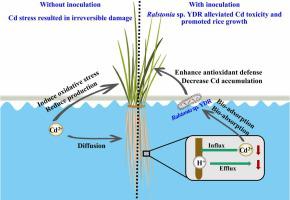当前位置:
X-MOL 学术
›
Environ. Technol. Innov.
›
论文详情
Our official English website, www.x-mol.net, welcomes your feedback! (Note: you will need to create a separate account there.)
Cadmium-resistant bacterium Ralstonia sp. YDR alleviated Cd toxicity in rice seedlings by enhancing antioxidant defense and inhibiting Cd2+ influx and H+ efflux
Environmental Technology & Innovation ( IF 7.1 ) Pub Date : 2024-03-29 , DOI: 10.1016/j.eti.2024.103614 Dai-Xia Yin , Li-Lu Niu , Jing Liu , Rui Yang , Bing Han , Zhou-Yu Liu , Yong-He Han , Xiao-Li Zhao
Environmental Technology & Innovation ( IF 7.1 ) Pub Date : 2024-03-29 , DOI: 10.1016/j.eti.2024.103614 Dai-Xia Yin , Li-Lu Niu , Jing Liu , Rui Yang , Bing Han , Zhou-Yu Liu , Yong-He Han , Xiao-Li Zhao

|
Cadmium (Cd) accumulation in rice ( L.) and its potential risks for human health have attracted great attention. Several Cd-resistant bacteria can promote plant growth and alleviate Cd toxicity to rice, but how they regulate Cd flux in rice roots is still poorly understood. Here, a new Cd-resistant endophytic bacterium sp. YDR was isolated and used to evaluate its role in reducing rice Cd accumulation. sp. YDR tolerated 80 mg L Cd and removed amounts of Cd via bio-adsorption and bio-absorption. sp. YDR also harbored good alkalizing ability and exhibited typical plant growth-promoting characteristics. Hydroponic experiment showed that inoculation with sp. YDR not only significantly promoted rice growth but also decreased rice Cd by 14.4–41.3%. Further analyses verified the involvement of sp. YDR in increasing the activities of catalase, glutathione, peroxidase, and superoxide dismutase by 27.7–77.3%, 1.7–57.6%, 57.4–100.8%, and 5.31–60.2%, and decreasing the activity of malonaldehyde by up to 56% in rice seedlings as compared with control. Moreover, a significant reduction in Cd influx and H efflux occurred in rice roots after inoculating with sp. YDR. Collectively, bacterial adsorption and absorption of Cd, bacteria-aided antioxidation, and bacterial regulation of Cd and H fluxes all contributed to a low Cd accumulation in rice. Our study provides new clues to better understand microbial mechanisms underlying the low Cd accumulation in rice plants, which helps to enhance the production of low Cd rice in agricultural practice.
中文翻译:

耐镉细菌 Ralstonia sp. YDR 通过增强抗氧化防御和抑制 Cd2+ 流入和 H+ 流出来减轻水稻幼苗的 Cd 毒性
水稻(L.)中镉(Cd)的积累及其对人类健康的潜在风险引起了人们的高度关注。几种抗镉细菌可以促进植物生长并减轻镉对水稻的毒性,但它们如何调节水稻根部的镉通量仍知之甚少。在这里,一种新的抗镉内生细菌。分离出 YDR 并用于评估其减少水稻镉积累的作用。 sp。 YDR 耐受 80 mg L Cd,并通过生物吸附和生物吸收去除一定量的 Cd。 sp。 YDR还具有良好的碱化能力,表现出典型的植物促生长特性。水培实验表明,接种sp。 YDR不仅显着促进了水稻生长,而且使水稻Cd降低了14.4-41.3%。进一步的分析证实了 sp 的参与。 YDR 可使水稻中过氧化氢酶、谷胱甘肽、过氧化物酶和超氧化物歧化酶的活性提高 27.7-77.3%、1.7-57.6%、57.4-100.8% 和 5.31-60.2%,并使丙二醛的活性降低高达 56%幼苗与对照相比。此外,接种 sp. 后,水稻根部的 Cd 流入和 H 流出显着减少。 YDR。总的来说,细菌对 Cd 的吸附和吸收、细菌辅助的抗氧化以及细菌对 Cd 和 H 通量的调节都导致了水稻中 Cd 的低积累。我们的研究为更好地了解水稻低镉积累的微生物机制提供了新线索,有助于提高农业实践中低镉水稻的产量。
更新日期:2024-03-29
中文翻译:

耐镉细菌 Ralstonia sp. YDR 通过增强抗氧化防御和抑制 Cd2+ 流入和 H+ 流出来减轻水稻幼苗的 Cd 毒性
水稻(L.)中镉(Cd)的积累及其对人类健康的潜在风险引起了人们的高度关注。几种抗镉细菌可以促进植物生长并减轻镉对水稻的毒性,但它们如何调节水稻根部的镉通量仍知之甚少。在这里,一种新的抗镉内生细菌。分离出 YDR 并用于评估其减少水稻镉积累的作用。 sp。 YDR 耐受 80 mg L Cd,并通过生物吸附和生物吸收去除一定量的 Cd。 sp。 YDR还具有良好的碱化能力,表现出典型的植物促生长特性。水培实验表明,接种sp。 YDR不仅显着促进了水稻生长,而且使水稻Cd降低了14.4-41.3%。进一步的分析证实了 sp 的参与。 YDR 可使水稻中过氧化氢酶、谷胱甘肽、过氧化物酶和超氧化物歧化酶的活性提高 27.7-77.3%、1.7-57.6%、57.4-100.8% 和 5.31-60.2%,并使丙二醛的活性降低高达 56%幼苗与对照相比。此外,接种 sp. 后,水稻根部的 Cd 流入和 H 流出显着减少。 YDR。总的来说,细菌对 Cd 的吸附和吸收、细菌辅助的抗氧化以及细菌对 Cd 和 H 通量的调节都导致了水稻中 Cd 的低积累。我们的研究为更好地了解水稻低镉积累的微生物机制提供了新线索,有助于提高农业实践中低镉水稻的产量。



























 京公网安备 11010802027423号
京公网安备 11010802027423号